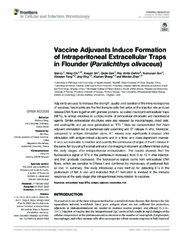Vaccine Adjuvants Induce Formation of Intraperitoneal Extracellular Traps in Flounder (Paralichthys olivaceus)
Permanent link
https://hdl.handle.net/10037/26209Date
2022-03-30Type
Journal articleTidsskriftartikkel
Peer reviewed
Author
Li, Qian; Chi, Heng; Shi, Xueyan; Gan, Qiujie; Dalmo, Roy Ambli; Sun, Yuan-Yuan; Tang, Xiaoqian; Xing, Jing; Sheng, Xiuzhen; Zhan, WenbinAbstract
Adjuvants are used to increase the strength, quality, and duration of the immune response
of vaccines. Neutrophils are the first immune cells that arrive at the injection site and can
release DNA fibers together with granular proteins, so-called neutrophil extracellular traps
(NETs), to entrap microbes in a sticky matrix of extracellular chromatin and microbicidal
agents. Similar extracellular structures were also released by macrophages, mast cells,
and eosinophils and are now generalized as “ETs.” Here we demonstrated that Alum
adjuvant stimulation led to peritoneal cells swarming and ET release in vitro. Moreover,
compared to antigen stimulation alone, ET release was significantly increased after
stimulation with antigen-mixed adjuvants and in a time- and dose-dependent manner.
In vivo, we were able to monitor and quantify the continuous changes of the ET release in
the same fish by using the small animal in vivo imaging instrument at different times during
the early stages after intraperitoneal immunization. The results showed that the
fluorescence signal of ETs in the peritoneum increased from 0 to 12 h after injection
and then gradually decreased. The fluorescence signals came from extracellular DNA
fibers, which are sensitive to DNase I and confirmed by microscopy of peritoneal fluid
ex vivo. In summary, this study introduced a new method for detecting ETs in the
peritoneum of fish in vivo and indicated that ET formation is involved in the immune
response at the early stage after intraperitoneal immunization to vaccines.
Publisher
Frontiers MediaCitation
Li, Chi, Shi, Gan, Dalmo, Sun, Tang, Xing, Sheng, Zhan. Vaccine Adjuvants Induce Formation of Intraperitoneal Extracellular Traps in Flounder (Paralichthys olivaceus). Frontiers in Cellular and Infection Microbiology. 2022;12Metadata
Show full item recordCollections
Copyright 2022 The Author(s)


 English
English norsk
norsk